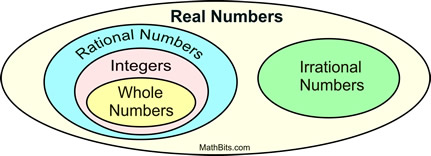

It's not known whether C and aleph-one are the same or not, and if they're not, we don't know which is bigger. There are also an infinite number of irrational numbers, but it's a "bigger" kind of infinity called C or the "power of the continuum." There's a relationship between aleph-null and a larger infinity called aleph-one. The mathematical designation for the kind of infinity that the integers have is called aleph-null. There are an infinite number of integers, and therefore an infinite number of rational numbers, but the two infinities are of the same order of magnitude (called a countable or listable infinity). Natural numbers are countable numbers and are preferable for calculations. (fractions) can be expressed as terminating or repeating decimals. Natural numbers are the positive integers, including numbers from 1 to infinity. Can be expressed as a ratio of two Integers: a/b, (b 0) such ratios. However, the sets of real numbers, imaginary numbers, and complex. Examples can be 39, 696, 63, 05110, and so on. In mathematics, numbers are of different types - Natural Numbers, Whole Numbers, Integers, Real Numbers, Rational Numbers, Irrational Numbers, and Complex Numbers. The set of natural numbers and the set of rational numbers have the same cardinality as Z.

Irrational numbers are those that cannot be represented exactly by the ratio of two integers some familiar irrational numbers are pi and the square root of 2. Natural Numbers refer to non-negative integers (all positive integers). Rational numbers are those that are representable as the ratio of two integers: 2/3, 355/113, 5 (=5/1). There are more irrational numbers between 0 and 1 than there are rational numbers period.I was kind of guessing what you were trying to ask, so let me explain some background in case that wasn't quite it. There are infinitely many rational numbers, but there are infinitely more irrational numbers than rational numbers. If the number does not need a decimal or fraction. If it is already in fraction form, check if it simplifies to a non-fraction. Are there rational numbers then irrational numbers? Step 1: Determine if the number has a decimal or fraction part. When two natural numbers or whole numbers are multiplied, then it always results in natural numbers and whole numbers, respectively.


 0 kommentar(er)
0 kommentar(er)
